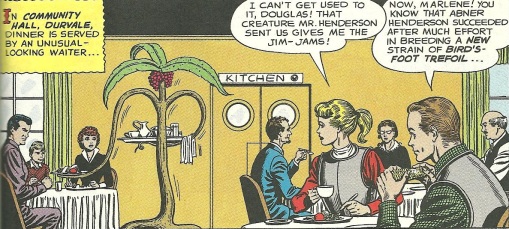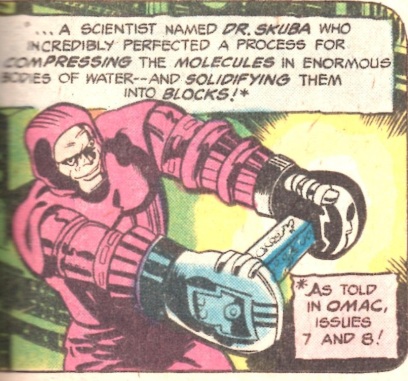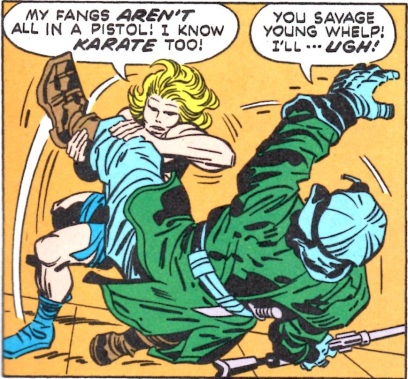Welcome back, Nerds! Today we’ll be looking at Part Three of our multi-part feature on the history of John Broome and Murphy Anderson’s 1960 masterpiece, The Atomic Knights! To get caught up, check out part one here and part two here.
A Brief History of the Atomic Knights, Part III
When we last left our heroes, they had carved out quite the life for themselves in the hellish landscape of a post-apocalyptic war. Well, I say “hellish,” but the Great Nuclear War of 1986 (which lasted only twenty days!) didn’t seem to have that many negative effects on the planet. Sure, you have the occasional mole man uprising, but by and large, the Knights have done well as the protectors of their little community. They re-established communications with Los Angeles and New Orleans, revitalized the automotive industry, and even founded a quaint diner:

By my count, this makes them more successful at economic growth than any presidential candidate of the past twenty years.
But by 1964, the Atomic Knights had all but disappeared, riding on giant Dalmatians off into the radioactive sunset. They would remain dormant for another thirteen years, until Gerry Conway and Jose Luis Garcia-Lopez would resurrect them as part of another one of DC’s stranger titles:

A Brief History of the Atomic Knights, Part III: Enter the Man-God!
Hercules Unbound strikes me as odd, even after devouring every page. Walk through this with me, Sleepwalkers: you want to do a story centered around adventures in a blasted, post-apocalyptic landscape (in the vein of, say, Broome and Anderson’s Atomic Knights), so you naturally make the decision to center it around this guy, a Greek Roman Hellenistic demi-god…

A blind kid and his dog, Basil…

And this girl, who doesn’t really do much, but certainly has an eye for the male form:

Not the direction I would have taken it in, but I guess that’s why I just read the books instead of write ‘em. Or maybe it’s just ’cause the 70s were a really weird time. Whichever.
Anyway, Hercules Unbound immediately comes off as the spiritual successor to the Atomic Knights, in that it’s a zany, action-packed romp through a world blown apart by a recent nuclear war. There’s the same amount of over-the-top action, except this time it’s less dependent on hand-waved pseudo-scientific “radiation” and more the fact that the war was caused by a literal Greek god, so, you know, it’s understandable that a little magic would get out here and there.

That’s why, in addition to things like the Loch Ness monster and talking animals, you get things like minotaurs and Cerberus–
Wait. Talking animals?

This is where things start to get very interesting (yeah, that’s right. It hasn’t been interesting until now). You see, up until this point, Hercules Unbound had been pretty content to live in its own little war-ravaged world. But with issue four, a larger scope began to emerge as Conway tied together elements from DC’s past to make Hercules Unbound part of a larger story.
You see, Hercules isn’t just chokeslamming a cat person; it’s heavily implied that he’s chokeslamming one of THESE cat people:

That panel is from Kamandi, the Last Boy on Earth #1, written and illustrated by none other than Jack Kirby himself. It takes place in a world wrecked by something called the Great Disaster, where the fantastic has become mundane, monsters roam the countryside, and the world as we know it is no more (sound familiar?).
By including the animal men (Ani-Men?) in his story, Conway has suggested that the Great Disaster, was, in fact, the great nuclear war that Ares started up (as the series goes on, you realize Ares caused humans to exterminate each other pretty much for kicks). That’s pretty clever, but it’s hardly worth mentioning, right?
That’s when these guys show up.

This issue, written by the legendary Cary Bates and illustrated by the equally legendary Walt Simonson, centers around an outrageous phenomenon: all around the world, water is disappearing. It’s not the work of the Crystal Monster from the pages of the Atomic Knights–instead, the water is being replaced by bricks of water that weigh thousands of tons.
As we dramatically see at the beginning of the issue, chipping the blocks releases energy “a thousand times more DEADLY than a hydrogen bomb!” Hercules, Jennifer, and Kevin tool on over to Lake Ontario, where they meet the Knights, who are just as perplexed by the disappearance of their lake as everyone else.
In the grand tradition of super-hero meet ups, Hercules and the Knights fight for a few pages before they decide to work together. The big draw of this issue is the off-panel death of Bryndon the scientist. It’s okay–he gets replaced by a being of pure energy (?) that was released from a nearby meteor (??) and draws power from the potential energy in the water blocks (!). There’s a fight, “Bryndon” is killed by an exploding Lake Ontario, and the entire thing is forgotten by the next issue.
So, you know. Pretty much standard Atomic Knights fare.
This issue is remarkable for two reasons: one, it actually succeeds in making a story that’s as crazy, if not more so, than a ’60s Atomic Knights story. Two, it makes explicit the fact that the Great Nuclear War of 1986 (that only lasted twenty days!) was the same one that Ares started. So what does that mean, other than that Conway was a fan of kooky Silver Age stories? It means that the Great Disaster…

WAS the GNW ’86 (onescore days long!)!
But that’s not all. First of all, there’s the small matter of the Atomic Knights meeting up with a literal mythical figure (which, given their history, doesn’t surprise them all that much). Second, there’s a slightly smaller problem: someone is taking all of the water in the world and compressing it into bricks.
Now, statistically speaking, if you’re reading this blog, you’re not only more attractive than the general population, you’re also more intelligent, so you already picked up on the fact that “compressing water into bricks” was the plot of another comic book story. Specifically, this one:

That’s from OMAC, which was also written and illustrated by Jack Kirby. And this isn’t an implied connection, either; the Atomic Knights mention the mad scientist who is responsible by name, and there’s an editor’s note (remember those?) directing the reader to OMAC issues 7 and 8.

So what do we have? Well, we’ve got obscure characters from 1964 guest-starring in a comic about Hercules in an issue that explicitly references a title that got cancelled after eight issues two years earlier. And Jack Kirby had already tied OMAC to Kamandi by having Buddy Blank (the eponymous One Man Army) be Kamandi’s grandfather. So what does that mean?
It means while THIS is going on…

And Hercules is doing THIS…

OMAC had already done THIS…

Setting the stage for Kamandi to do THIS:

And all because Cary Bates decided that a story about a man in a skirt wandering around a post-apocalyptic world would be improved by making it canon with a thirteen-year-old story about dudes riding around on giant dogs.
And that’s why comics are awesome.
That’s all the time we have for today, Nerds. Stay tuned for the fourth installment of our complete history of the Atomic Knights, where everything changes. Or get caught up on part one here and part two here.

